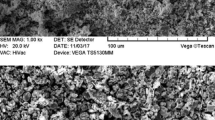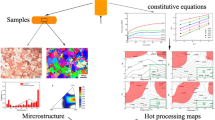Abstract
Microstructures of Cu–4.7Sn (%) alloys prepared by two-phase zone continuous casting (TZCC) technology contain large columnar grains and small grains. A compound grain structure, composed of a large columnar grain and at least one small grain within it, is observed and called as grain-covered grains (GCGs). Distribution of small grains, their numbers and sizes as well as numbers and sizes of columnar grains were characterized quantitatively by metallographic microscope. Back propagation (BP) artificial neural network was employed to build a model to predict microstructures produced by different processing parameters. Inputs of the model are five processing parameters, which are temperatures of melt, mold and cooling water, speed of TZCC, and cooling distance. Outputs of the model are nine microstructure quantities, which are numbers of small grains within columnar grains, at the boundaries of the columnar grains, or at the surface of the alloy, the maximum and the minimum numbers of small grains within a columnar grain, numbers of columnar grains with or without small grains, and sizes of small grains and columnar grains. The model yields precise prediction, which lays foundation for controlling microstructures of alloys prepared by TZCC.




Similar content being viewed by others
References
Steele D, Evans D, Nolan P, Lloyd DJ. Quantification of grain boundary precipitation and the influence of quench rate in 6XXX aluminum alloys. Mater Charact. 2007;58(1):40.
Levinson AJ, Rowenhorst DJ, Lewis AC. Quantification of microstructural Evolution in grain boundary networks. JOM. 2014;66(5):774.
Yang D, Liu Z. Quantification of microstructural features and prediction of mechanical properties of a dual-phase Ti–6Al–4V alloy. Materials. 2016;9(8):1.
McGarrity KS, Sietsma J, Jongbloed G. Characterisation and quantification of microstructural banding in dual phase steels part 1-general 2D study. Mater Sci Technol. 2012;28(8):895.
Collins PC, Welk B, Searles T, Tiley J, Russ JC, Fraser HL. Development of methods for the quantification of microstructural features in α + β–processed α/β titanium alloys. Mater Sci Eng A. 2009;508(1–2):174.
Kimura Y, Inoue T, Yin F, Tsuzak K. Inverse temperature dependence of toughness in an ultrafine grain-structure steel. Science. 2008;320(5879):1057.
Yvell K, Grehk TM, Engberg G. Microstructure characterization of 316L deformed at high strain rates using EBSD. Mater Charact. 2016;122:14.
Tseng LW, Ma J, Vollmer M, Krooß P, Niendorf T, Karaman I. Effect of grain size on the superelastic response of a FeMnAlNi polycrystalline shape memory alloy. Scr Mater. 2016;125:68.
Tiley J, Searles T, Lee E, Kar S, Banerjee R, Russ JC, Fraser HL. Quantification of microstructural features in α/β titanium alloys. Mater Sci Eng A. 2004;372(1–2):191.
Liu XF, Luo JH, Wang XC, Wang L, Xie JX. Columnar grains-covered small grains Cu–Sn alloy prepared by two-phase zone continuous casting. Prog Nat Sci. 2013;23(1):94.
Liu XF, Luo JH, Wang XC. Surface quality, microstructure and mechanical properties of Cu–Sn alloy plate prepared by two-phase zone continuous casting. Trans Nonferr Met Soc China. 2015;25(6):1901.
Lin YC, Chen XM. A critical review of experimental results and constitutive descriptions for metals and alloys in hot working. Mater Des. 2011;32(4):1733.
Reddy N, Lee YH, Park CH, Lee CS. Prediction of flow stress in Ti–6Al–4V alloy with an equiaxed α + β microstructure by artificial neural networks. Mater Sci Eng A. 2008;492(12):276.
Tao ZJ, Yang H, Li H, Ma J, Gao PF. Constitutive modeling of compression behavior of TC4 tube based on modified Arrhenius and artificial neural network models. Rare Met. 2016;35(2):162.
Kusiak J, Kuziak R. Modelling of microstructure and mechanical properties of steel using the artificial neural network. J Mater Process Technol. 2002;127(1):115.
Yu X, Ye C, Xiang L. Application of artificial neural network in the diagnostic system of osteoporosis. Neurocomputing. 2016;214:376.
Lu C. Study on prediction of surface quality in machining process. J Mater Process Technol. 2008;205(1–3):439.
Luca D. Neural networks for parameters prediction of an electromagnetic forming process of FeP04 steel sheets. Int J Adv Manuf Technol. 2015;80(1–4):689.
Guo L, Li B, Zhang Z. Constitutive relationship model of TC21 alloy based on artificial neural network. Trans Nonferr Met Soc China. 2013;23(6):1761.
Powar A, Date P. Modeling of microstructure and mechanical properties of heat treated components by using artificial neural network. Mater Sci Eng A. 2015;628:89.
Zhou J, Wan X, Zhang J, Yan Z, Li Y. Modeling of constitutive relationship of aluminum alloy based on BP neural network model. Mater Today. 2015;2(10):5023.
Zhao J, Ding H, Zhao W, Huang M, Wei D, Jiang Z. Modelling of the hot deformation behaviour of a titanium alloy using constitutive equations and artificial neural network. Comput Mater Sci. 2014;92(5):47.
Luo J, Li M. Modeling of grain size in isothermal compression of Ti–6Al–4V alloy using fuzzy neural network. Rare Met. 2011;30(6):555.
Jiang L, Wang A, Tian N, Zhang W, Fan Q. BP neural network of continuous casting technological parameters and secondary dendrite arm spacing of spring steel. J Iron Steel Res Int. 2011;18(8):25.
Haghdadi N, Zarei-Hanzaki A, Khalesian AR, Abedi HR. Artificial neural network modeling to predict the hot deformation behavior of an A356 aluminum alloy. Mater Des. 2013;49:386.
Setti SG, Rao RN. Artificial neural network approach for prediction of stress–strain curve of near β titanium alloy. Rare Met. 2014;33(3):249.
Ozerdem MS, Kolukisa S. Artificial neural network approach to predict the mechanical properties of Cu–Sn–Pb–Zn–Ni cast alloys. Mater Des. 2009;30(3):764.
Sun W, Tian M, Zhang P, Wei H, Hou G, Wang Y. Optimization of plating processing, microstructure and properties of Ni–TiC coatings based on BP artificial neural networks. Trans Indian Inst Met. 2016;69(8):1501.
Djavanroodi F, Omranpour B, Sedighi M. Artificial neural network modeling of ECAP process. Mater Manuf Process. 2013;28(3):276.
Sun Z, Yang H, Tang Z. Microstructural evolution model of TA15 titanium alloy based on BP neural network method and application in isothermal deformation. Comput Mater Sci. 2010;50(2):308.
Acknowledgements
This work was financially supported by the National Key Research and Development Plan of China (No. 2016YFB0301300), the National Natural Science Foundation of China (Nos. 51374025, 51674027 and U1703131), and the Beijing Municipal Natural Science Foundation (No. 2152020).
Author information
Authors and Affiliations
Corresponding author
Rights and permissions
About this article
Cite this article
Luo, JH., Liu, XF., Shi, ZZ. et al. Microstructure quantification of Cu–4.7Sn alloys prepared by two-phase zone continuous casting and a BP artificial neural network model for microstructure prediction. Rare Met. 38, 1124–1130 (2019). https://doi.org/10.1007/s12598-018-1023-0
Received:
Revised:
Accepted:
Published:
Issue Date:
DOI: https://doi.org/10.1007/s12598-018-1023-0




